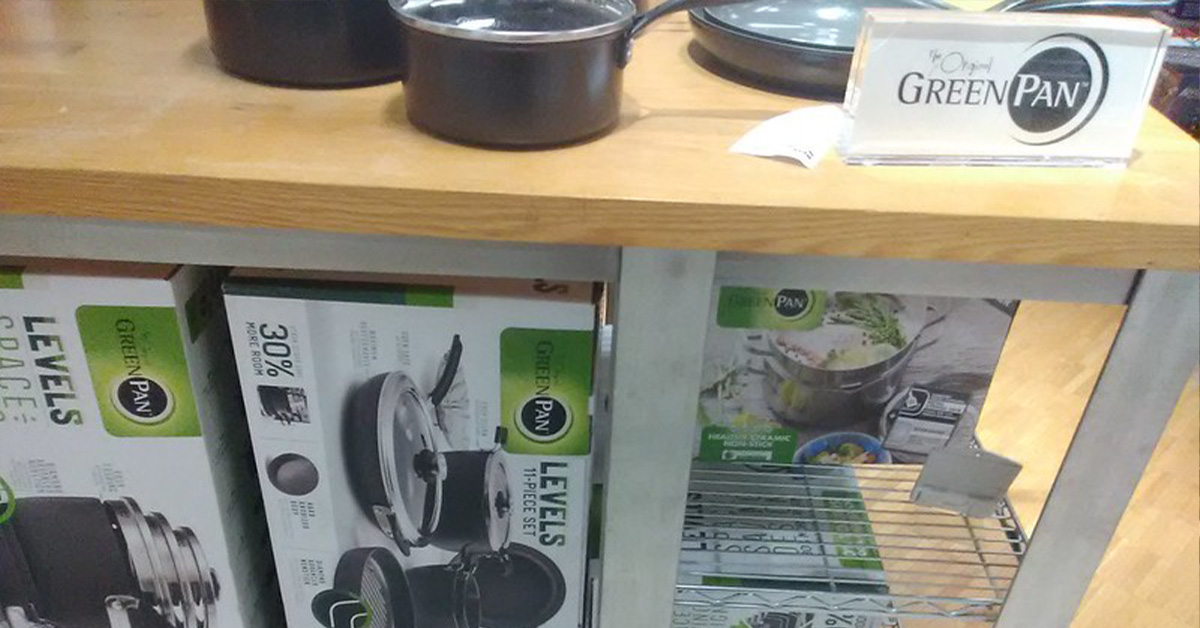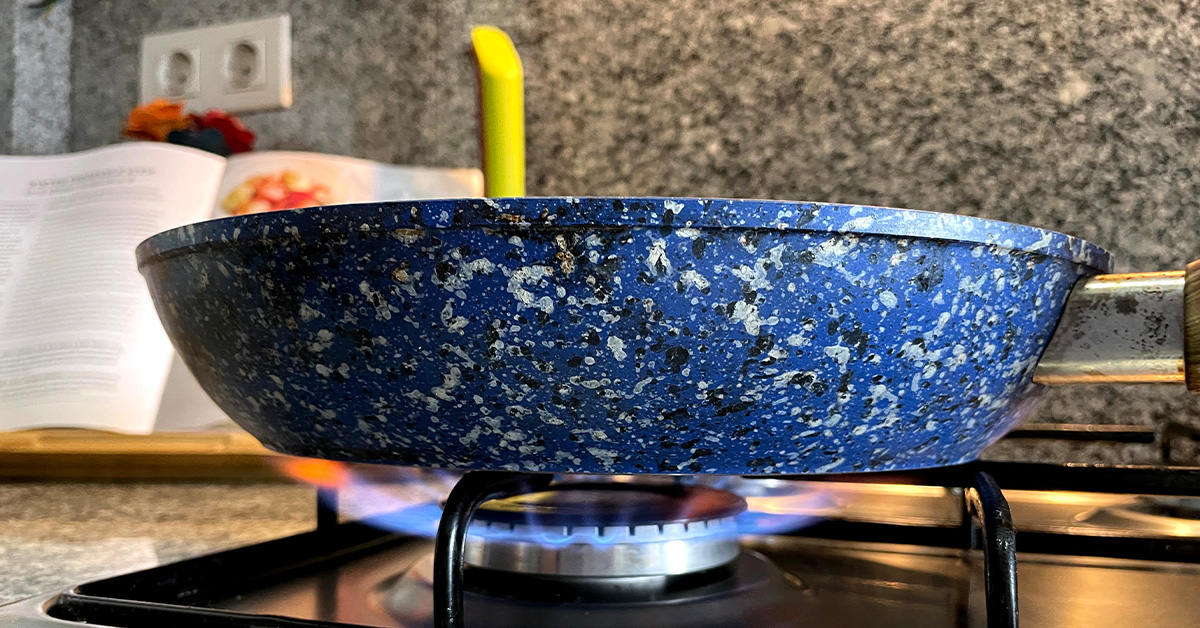The ultimate guide to pots and pans
When looking for a new set of pots and pans there is a lot to consider. There are many types of construction materials, lots of different types of pan, and plenty of high quality brands that have their own take on what makes a great pan. We’ve created this guide to help you navigate the dizzying market of kitchen cookware, and to help you choose the right pan for the right job. We’ll also show you which pans are best on the different types of hob and stove top as well as how to maintain and store your pans so they’ll last a lifetime.
Key Considerations
To first understand what pots and pans will suit your cooking style best, you should understand the key qualities each pan may have. It’s not only about performance – some pans can make up for their thermal qualities with reduced maintenance.
Heat Conductivity
The heat conductivity of your pan, for example, is what determines how fast it will heat up. Pans with ‘good’ heat conductivity are pans that respond quickly to a heat source, heating up rapidly.
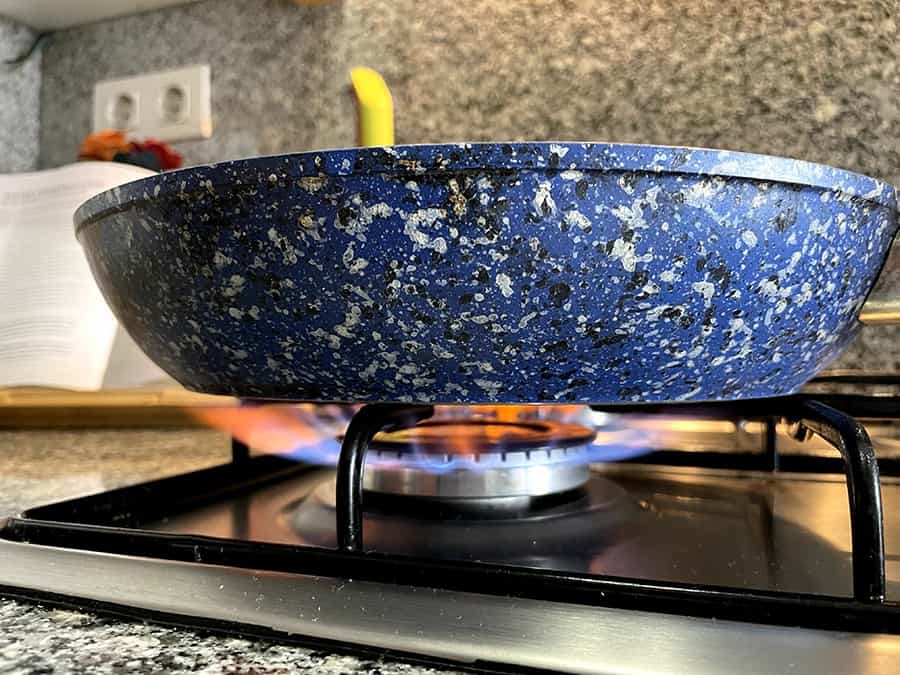
Pans made from materials such as copper have great heat conductivity, but there is a tradeoff. Copper is also reactive, meaning that if you cook with particularly acidic foods, the copper can react with your food, lending it a slightly metallic taste. If you cook with acidic foods often, or fancy less maintenance, you should consider pans which aren’t reactive, such as stainless steel pans, or pans which have been treated to prevent this.
Durability
Durability is another primary concern when buying kitchenware. Some materials, such as cast iron, are strong enough that you never have to worry about damage. But, as always, there are some tradeoffs. Raw cast iron can be liable to corrosion, for example. Some materials, such as copper or aluminum, boast impressive heat conductivity and are lightweight, but can dent easily. These materials are also soft enough to be scratched by kitchen utensils, unless they are treated with care.
Maintenance
The maintenance required by pans is another essential factor in these tradeoffs. Pans which are reactive, less corrosion resistant or harder to clean will require more love and care to keep them in good condition. You may have to choose between ultimate performance and ease of use in this case.
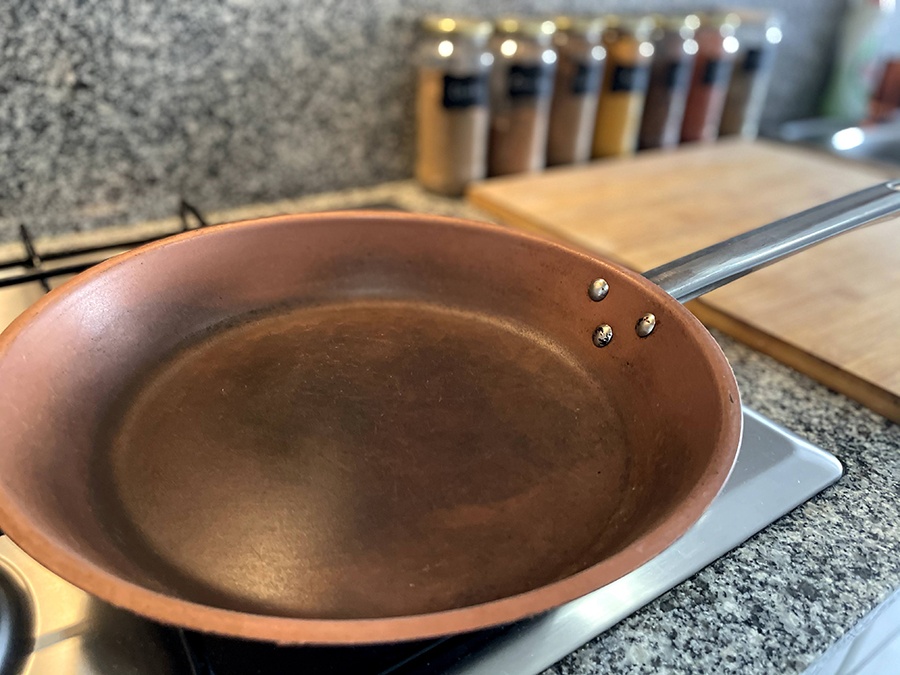
Price
But we should also discuss one of the key considerations: price. Premium pots and pans come at a premium price, and you may instead be swayed by a better value option. Some materials, such as stainless steel, are easy to manufacture with and hence these pots tend to be cheaper. More advanced techniques such as clad construction command a price premium, and you’ll see why in the cookware materials section below.
The Parts of the Pan
In order to understand how pots and pans are designed to aid your cooking, it’s helpful to know the purpose behind their individual components. Modern pots and pans might maintain a simple overall aesthetic, but if you look closely at the best pots or pans, you’ll notice several key features have been tuned to maximize cooking benefit.
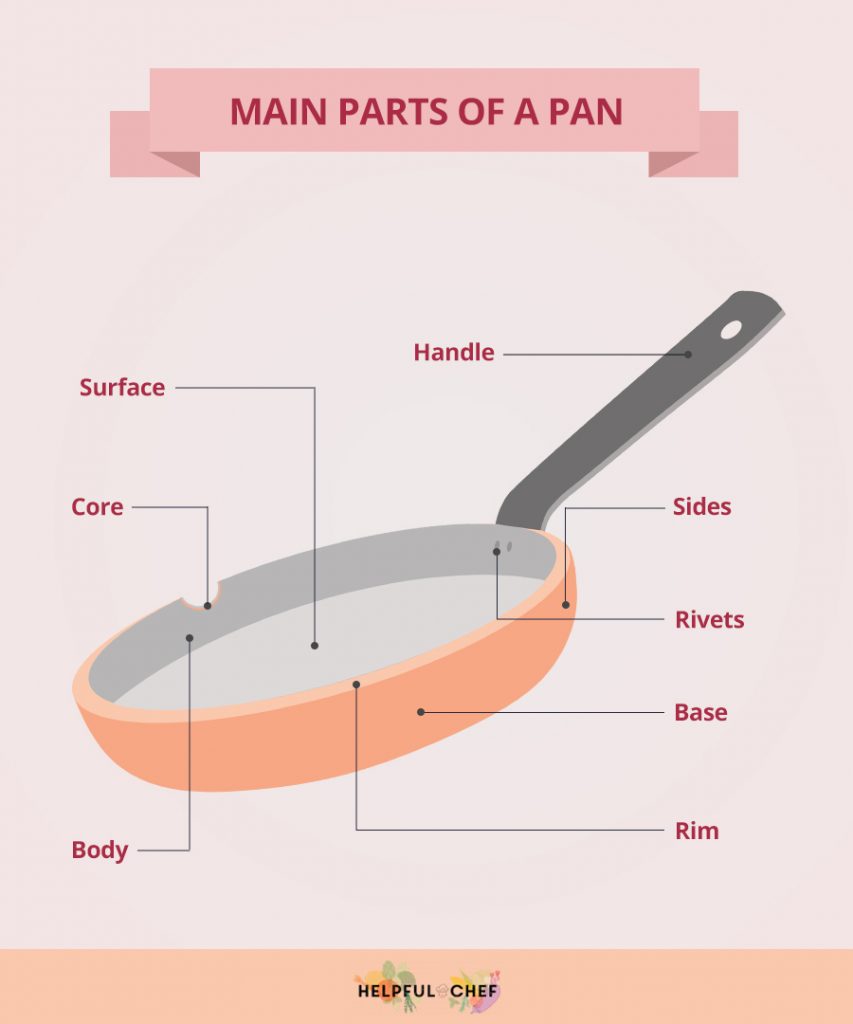
The Handle
One obvious yet critical feature is the handle. You need a firm, reliable hold on your cookware when you’re moving a pot full of boiling water across the heat from your stove. Handles to a pot or pan must be able to stay cool, while also providing comfort and dependable strength. That’s why you’ll typically see a metal core to pan handles, with a molded plastic resin handle to give you grip. Pans with plastic handles, unlike the handles used on fully cast-iron pans for example, can’t be used in the oven, however.(1) Many handles will also integrate a heat guard, to ensure your handle stays cool even under extreme temperatures.
The handle will often be fixed to a pan’s side with rivets, which are fixed pins of metal that permanently secure a handle to a pot or pan’s side. This isn’t the only method of securing a handle however – many pans are instead screwed onto the pan. Screw-fixed handles can become loose over time. When this begins to happen, all you need to do if give the screw a quick turn with a screwdriver until it’s tight again.
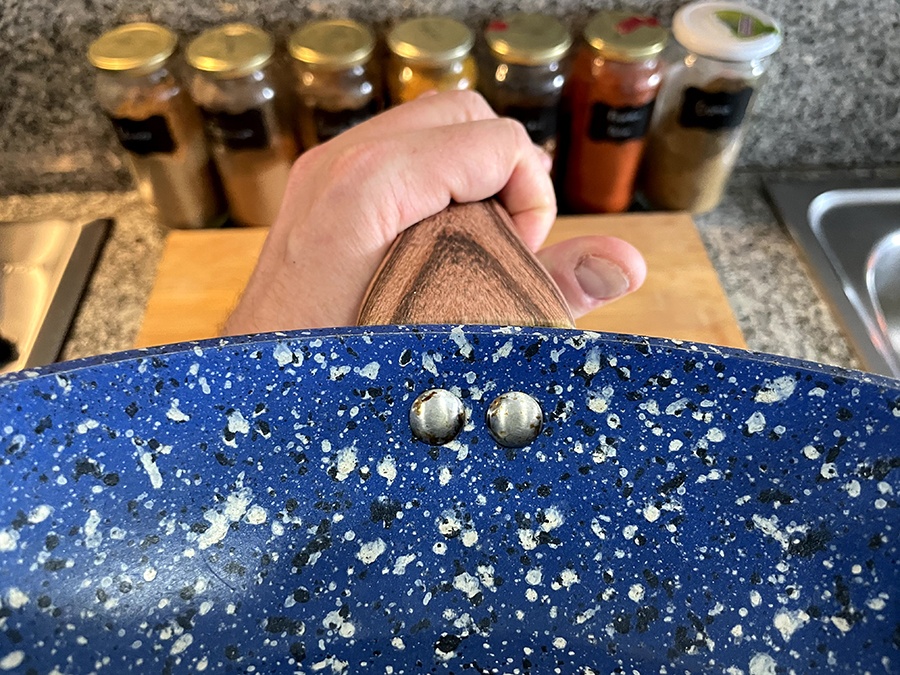
The Body and the Sides
The body of the pan is the part that provides the shape to your pot or pan. It’s important to consider what you will be cooking when you choose a pan, as the shape of the body may limit what you can do with it. What you can’t see however is the core of the pan – many stainless steel pots and pans use an aluminum or copper core to help heat to spread evenly.
The height of a pan’s sides are what determine whether it is considered a pan or a pot – high sides are characteristic of a pot, while pans use low, curved sides. Low sides with a shallow angle can help to evaporate and reduce sauces, and also let you rock your food as you cook it, as you would with a wok, for example.
The Surface
The surface of pans is often coated in a non-stick coating. We’ll explain how this works in the Cookware Materials section below. You’ll also need to check that the base of your pan is compatible with your stovetop. The base is responsible for ensuring heat is spread evenly across your food, without any hot-spots.
The Lid
Not all pots and pans come with a lid, so it’s worth checking for one if you’d like one. These are typically made wither either glass, which helps you to monitor your cooking, or the material of your pot, which tends to be more effective at insulating your food. They may also feature a steam hole to help prevent boiling over. Some use a heat shield, making it easier to lift up your lid in extreme heat scenarios.(2)
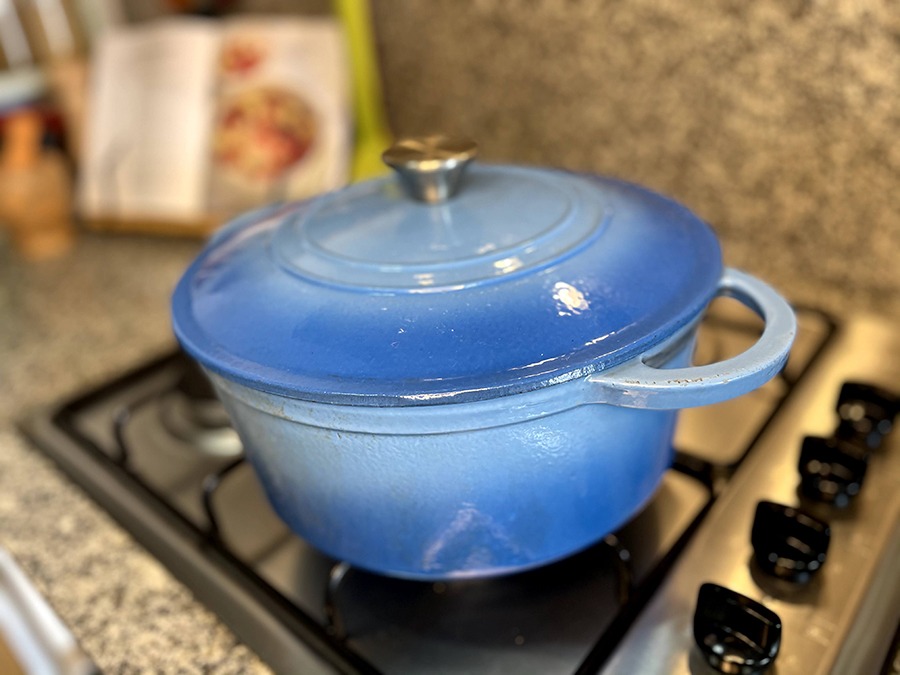
The Different Types of Pan
As you might expect, different pots and pans are specialized for different tasks. You won’t need every pot or pan, but it’s helpful to have a range that best reflects the cooking that you like best.
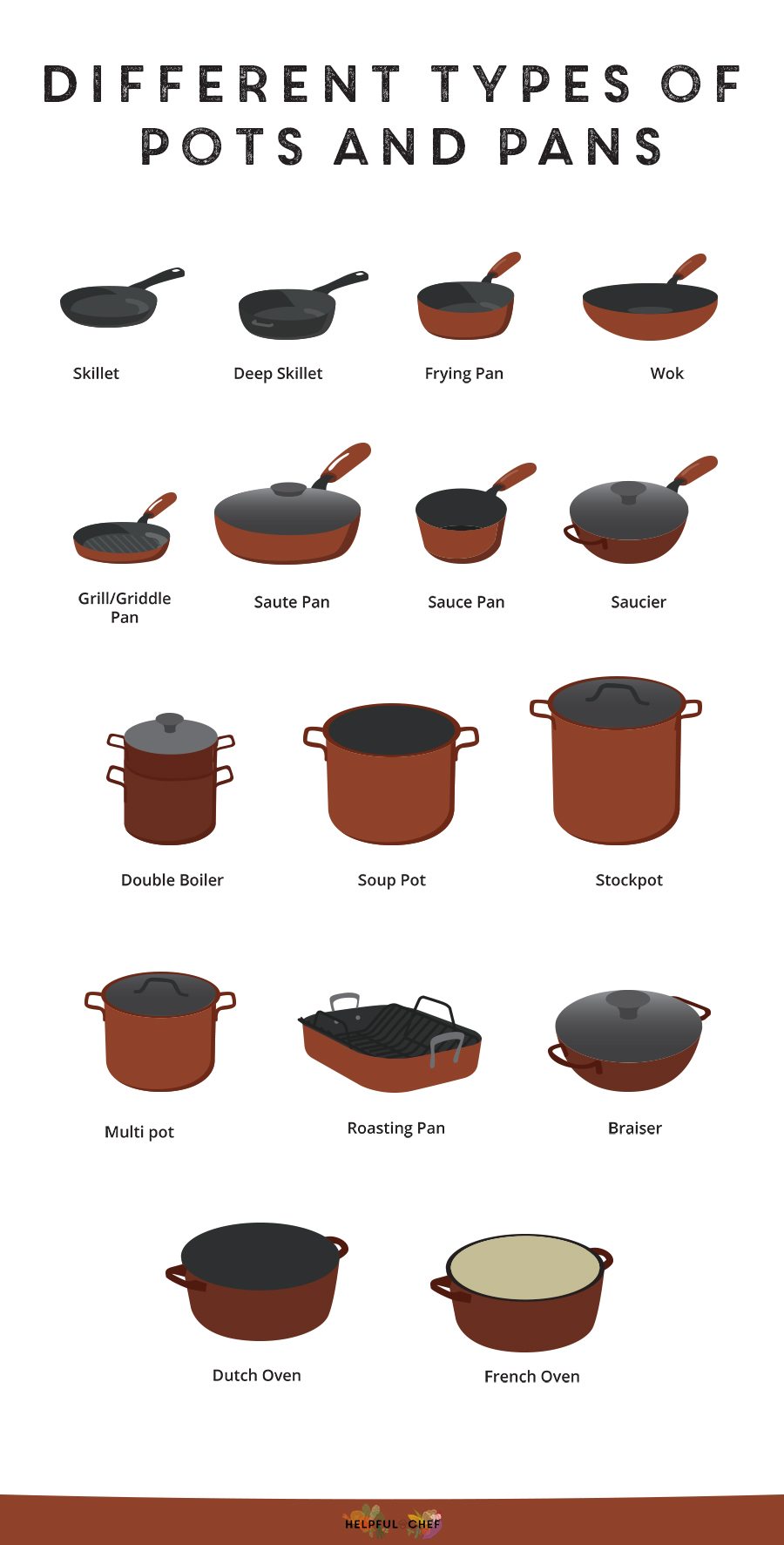
Stovetop pans and pots
Let’s look at some of the classic pots you’ll use when cooking on your stovetop.
Stock Pot
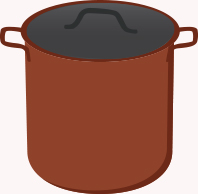
The stock pot’s classic design is perfect for food that doesn’t have to be too close to the heat source. Liquid-based foods, such as lobster, pasta, and their namesake of stock, use their liquid medium to transfer heat. Stock pot sizes can vary quite a lot, and it can be useful to keep at least a couple of sizes for different sized meals.
Pressure cookers offer a uniquely high-tech way to cook your food. They seal your food in, cooking it under steam pressure. Since the pressure of a gas is directly proportional to its temperature (Gay-Lussac’s law), this allows you to boil at far higher temperatures than normal.(3) This can half, or even quarter, your cooking times. Pressure cookers use valves to regulate the pressure, with some allowing you to set a pressure level, and include safety valves to release excess pressure.
Saucepan

The next step down in size is the saucepan. This versatile pot or pan is great at everything from boiling pasta, potatoes or eggs to making a delicious lunchtime soup. Like the stock pot, these tend to come with a lid, although a glass lid is more common than the stainless steel typically favored with stock pots.
Sauté Pan
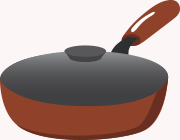
Sauté pans use low, straight sides to let you slowly fry or sauté foods such as onions, peppers and potatoes in oil. Their use of sides and lids make them versatile. The best sauté pans are also a great choice for deep frying and preparing sauces, too.
Skillet

Another excellent workhorse in the kitchen is the frying pan, also known as a skillet. These versatile pans are similar to sauté pans, but use shallower sides and curved edges to make them great for frying fast, and on a high heat. The rounded sides let you keep your food moving in the pan, and make these perfect for foods such as eggs, omelettes, and pancakes.
Wok
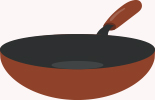
The curved edges of the frying pan are more pronounced in the larger, deeper wok. This lets you flick food upwards in the pan, circulating food around the pan to fry it evenly. Originating from China, the wok is best known for its use in cooking stir fry, but its large size makes it a very versatile kitchen tool.
Griddle

Similar to the frying pan, griddle pans are great for quick and easy breakfast cooking. These flat surfaces are great for quickly dishing up fried eggs, tomatoes, mushrooms, and pancakes. They often come in square shapes, letting you keep things simple, and some offer a textured surface, allowing you to quickly achieve succulent sear marks with your food.
Oven ready pans
Braiser Pan
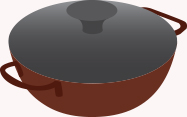
Braiser pans are designed primarily for braising: sautéing food at a high, dry temperature on the stovetop, and then cooking low and slow in the oven, with extra moisture added and trapped in by the lid. They often come with two fixed handles on either side, making them great for lifting and serving straight to the table.
Roasting Pan
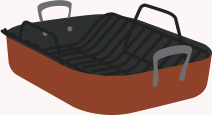
Roasting pans are made for the oven. The low sides of the pan allow heat to reach the food, and a large, rectangular base maximizes surface area for placing food.
Dutch Oven
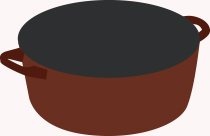
Dutch ovens, also known as casserole dishes, are designed for slow-cooking of stews and similar dishes. They have a long history, with the term ‘Dutch oven’ dating back to at least the 18th century, when cast-iron Dutch ovens were common.(4) They typically use a rounded design, with handles at each side, and a lid to keep the insides warm.
French Oven
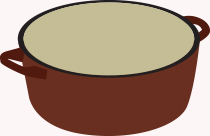
One variant of the Dutch oven is the French oven, also known as the enameled Dutch oven. Dutch ovens often need a coat of oil to season their interior, to prevent rust from forming and food from sticking to their insides. An enamel coating removes the need for this, letting you use it straight away.
Cookware materials
The biggest differentiator between pots and pans, besides their different types, is the material they are made of. To many, a pan is a pan. But a pan’s cooking characteristics, strength, and ease of use can vary drastically depending on the material used. That’s why we’ve created this list discussing each material’s relevant cooking qualities.
Stainless Steel
One of the most common materials for cookware is stainless steel. It’s simply a great all-rounder – it has stain resistance, rust resistance, it’s easy to clean, durable and lightweight. But it doesn’t excel in any one area particularly. The main criticism of stainless steel cookware is that it isn’t the best conductor of heat, so hot spots can form on your pan.
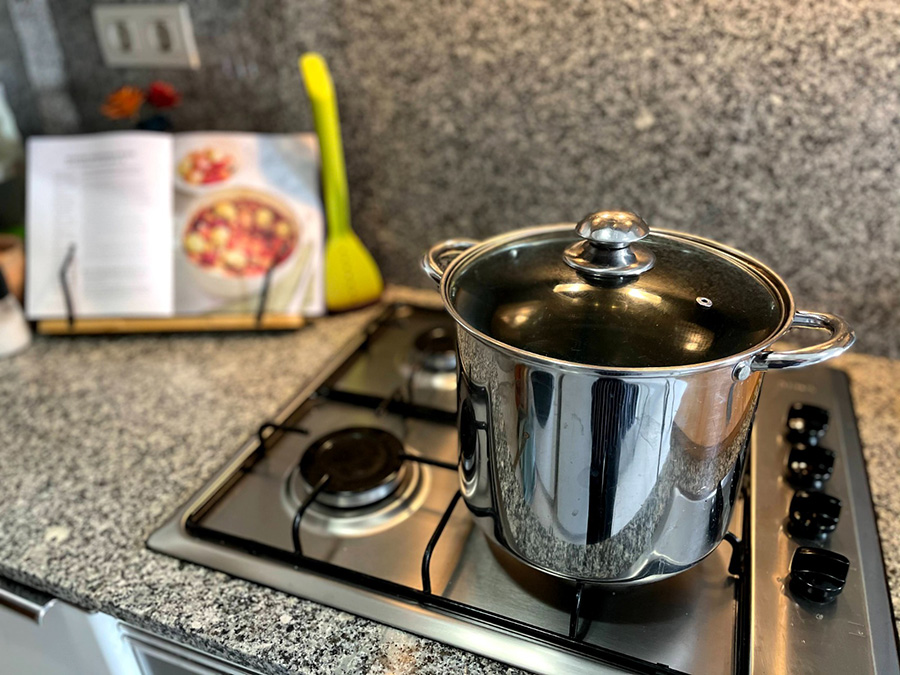
Aluminium
Aluminum is one of the most popular choices for modern cookware. It’s lightweight, durable, and a great conductor of heat. Not every aluminum pan will perform the same however. Thicker pans will be even better at preventing hot spots and spreading heat evenly, and higher-end aluminum cookware will be anodized to add to its strength.
Copper
The best conductor of heat is none of these materials above though – it’s copper. Copper will heat up rapidly under a heat source, and is best paired with a stovetop that can change temperature rapidly, such as a gas stovetop. Copper can react with some foods however, so it will often come coated with stainless steel to prevent this – at an added cost. For untreated copper, you may need to polish your pan periodically to maintain its red copper surface.
Carbon Steel
Carbon steel cookware has similar qualities to cast iron. It’s a poor conductor of heat, which means it can generate hot spots. However, this also means that once it gets hot, it stays hot. They are often oven friendly, and lighter than cast iron. Like cast iron, they will need a coat of seasoning before use, unless your pan is already treated with a non-stick coating.
Cast Iron
When it comes to cookware, cast iron is a classic. They may be heavy, but it’s hard to match a cast iron pot for strength. Their density also gives them excellent heat retention. However, untreated cast iron can rust, and its rougher surface can be a little difficult to clean. This can be amended by seasoning your pan by baking in a layer of oil before use.
If you don’t fancy this extra level of maintenance, an enamel-coated cast iron pan is a great option. The enamel coating prevents food from sticking to cast iron cookware, and the polished surface makes them easier to clean. However, with both ceramic and seasoned cast iron, you should be aware that acidic foods can degrade their surface coat. This is actually the same process by which acidic foods can damage your teeth’s enamel.(5)

Porcelain
Porcelain cookware offers a stress-free cooking experience. These pots and pans thanks to their polished surface. On top of this, they are also non-reactive, so you don’t have to worry about any chemicals entering your food, or any corrosion damaging your cookware. Porcelain clay is fired at a temperature of over 1300 degrees F in order to achieve an incredibly high strength.(6) Although porcelain is strong, it’s also brittle, so try not to drop it. Porcelain isn’t the only clay-fired ceramic cookware available however.
Stoneware
Stoneware is another ceramic available for kitchen cookware, similar to porcelain. It’s not as non-porous as porcelain, but since it’s easier to fire and produce, you’re likely to find stoneware at a more affordable price. The clay used to make stoneware can also come in other colors beyond white, too. Similarly, earthenware offers an even cheaper alternative, but this material is usually reserved for purposes where its fragility is not an issue.
Clad
Wish there was a way to combine the best of two different materials’ qualities? Clad kitchenware does just that. A common clad material is aluminum clad with stainless steel, for example. This gives you aluminum’s excellent heat conductivity, combined with stainless steel’s rust resistance and strength. Clad kitchenware can be very expensive, but they offer a combination of properties which is hard to match.
Non-stick Coatings
It’s also worth talking about the coatings used on cookware materials. Non-stick coatings will make various materials much easier to work with when cooking. However, stainless steel kitchen utensils can scratch and damage non-stick coatings. They’re best paired with soft silicone utensils, therefore.
Maintenance
One of the key considerations when buying a new set of pans is the maintenance required to keep them performing at the top level. Once you’re acquired some pans, it’s important that you know how to make them last. Maintenance for pots and pans depends on the material used in their construction, so we’ve broken down the maintenance needed for pots and pans by their material below.
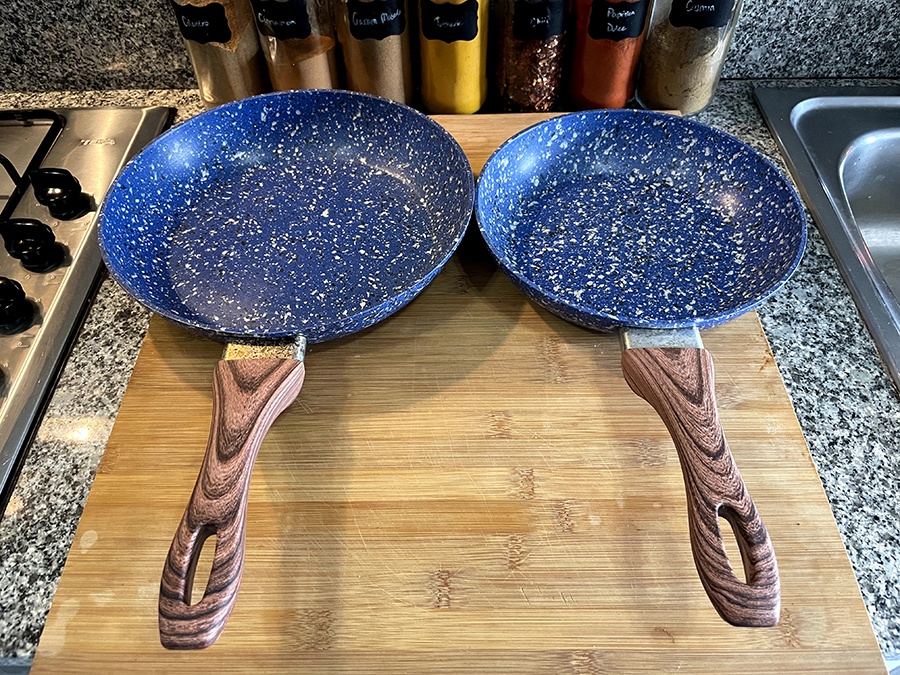
How to Maintain Stainless Steel Pots and Pans
Stainless steel pots and pans, as the name suggests, offer easy maintenance and cleanup. They are they only dishwasher safe pan (just check the handle on your pot or pan is, too), and non-porous, meaning you can leave them overnight without food seeping into the pan. Stainless steel pans are tough, so you shouldn’t worry too much about damaging them, and non-reactive, so it’s rare for them to be stained by your food.
How to Maintain Cast Iron Pans
Cast iron, by contrast, has some maintenance considerations you need to be aware of. Since it doesn’t have the polished, stick-resistant surface of stainless steel, you will need to season your cast iron cookware by burning in a coating of oil into the cooking surface. For this reason, you shouldn’t use any soap or detergent when cleaning your pan, as it will remove this patina. If any rust spots do develop, they can be rubbed off with sandpaper to restore the clean metal underneath.
Enamel-coated cast iron doesn’t require seasoning, as the enamel coat protects the iron from rust, as well as providing non-stick properties. This makes it a great option if you want low maintenance cast iron cookware. However, you will have to treat it with more care, as cooking utensils can scratch the enamel coating.
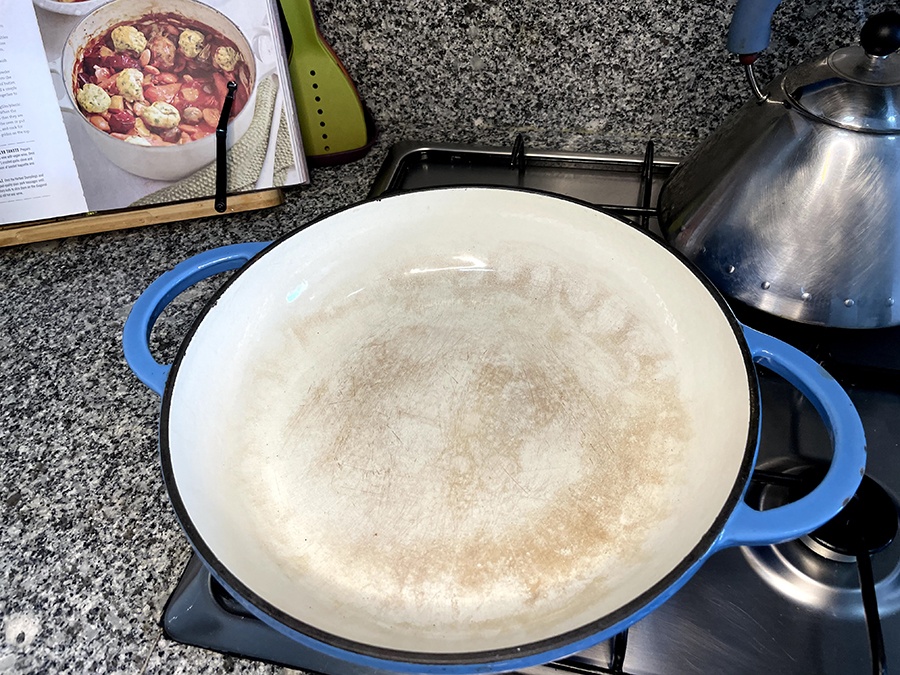
How to Maintain Porcelain Pans
Porcelain pots and pans can vary depending on their quality. The best porcelain pans are tough, but can be brittle, too, so you should avoid exposing it to any sudden drops or large impacts, as well as avoiding cleaning them in a dishwasher. If you have lower quality porcelain, it may be a little porous, meaning it’s best to clean it soon after use. On the whole however, porcelain is easy to clean and tough. We recommend hand-washing for best results.
How to Maintain Aluminum Pots and Pans
Aluminum has great heat conduction, but does require some care. Cleaning aluminum in a dishwasher can cause discoloration, so we recommend you stick to hand-washing aluminum pans. We also recommend you let aluminum pots cool before washing, as rapid temperature changes can cause some deformation.(7) Aluminum is softer than stainless steel, so you should be careful not to store aluminum pots near objects that could scratch them, too.
How to Maintain Carbon Steel Pans
Carbon steel pans essentially have the same care considerations as cast iron. Since they use a thinner construction, and often begin their lives as a single sheet of steel, they will require you to be a little more careful not to dent them than cast iron. But only a little – these pans are plenty tough. Like with cast iron, you should burn in a layer of oil to season the pan, which will protect them from corrosion, and you should ensure you don’t use any detergent when cleaning to maintain this coating. Hand wash your carbon steel pans, and dry it immediately after cleaning, and it will last you a long time.
How to Maintain Copper Pans
Copper, like aluminum, is reactive. Cooking with acidic foods can begin to discolor a raw copper pan, as well as imparting a metallic taste to your food. This discoloration can be remedied by polishing a pan gently with a lemon juice and soda solution, however. Like aluminum, copper is a soft metal, so you should be careful not to scratch it when using utensils and when storing your pans.
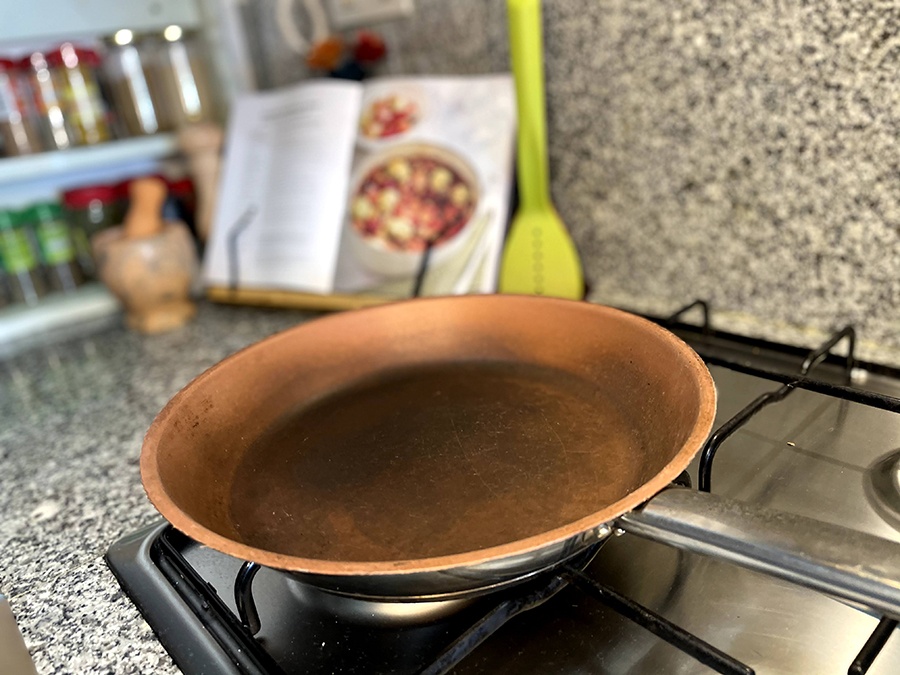
How to Maintain Clad Pans
Care for clad pans depends on what materials are used in the construction. The most common clad pan uses an aluminum core with a stainless steel exterior – if your pan uses this design, we recommend you read our section above on caring for stainless steel pans. If your pan has a different exterior to its clad construction however, then you can still find the relevant section above. The external material will have the largest impact on care considerations, although you may find it helpful to understand the properties of the material forming the core of your pan, too.
How to Maintain Non-stick Pans
The key with caring for non-stick pans is in protecting the coating. Non-stick coatings can help to protect your pan from corrosion and stains, but in order to do so you must make sure you don’t scratch off the coating with sharp cooking utensils. Soft silicone tools are a great match for non-stick pans, therefore. If you are still interested in using some metallic utensils with your cookware, pans with a ceramic non-stick coating, or even granite stone, as opposed to a Teflon/PTFE are more resistant to scratching, although you will still need to exercise caution. Non-stick pans without Teflon are becoming more and more common these days.
How to Store Pots and Pans
So, you’ve bought yourself a brand new set of pots and pans…but where to put them all? Pots and pans take up a lot of space, and sometimes it requires some ingenuity to get them tidied away. But don’t worry, because we’ve listed some of our favorite storage methods below.
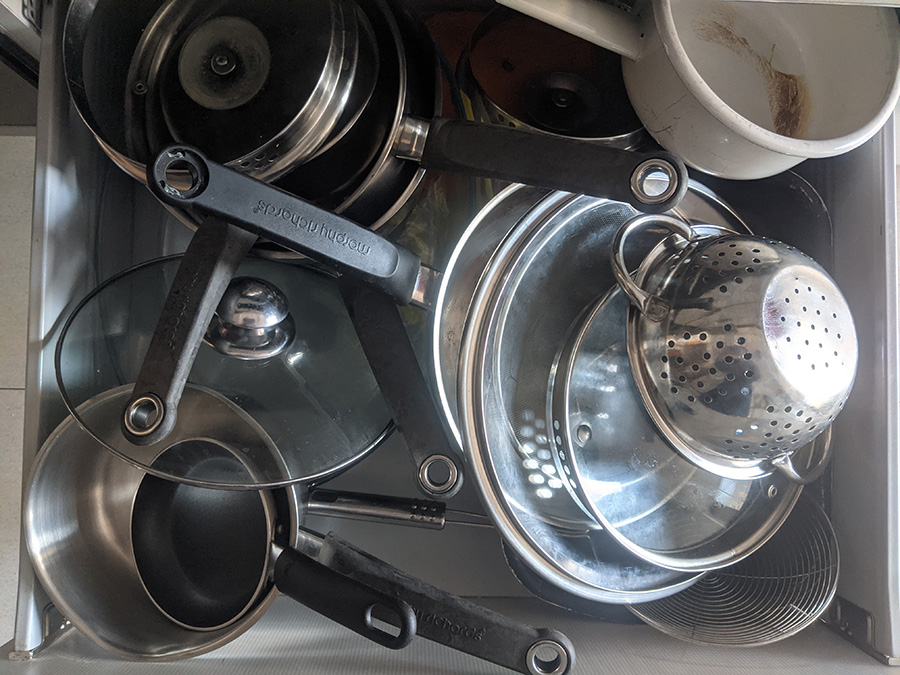
Corner Cabinets and Lazy Susans
Corner cabinets, with their awkward wrap-around hidden space, are great for tucking away pots and pans. Big pots are much easier to grab in these cupboards than small spice jars or ingredients, and with a few modifications they can be made much more convenient still. A rotating ‘Lazy Susan’, or a pop-out wire rack, can bring the pans hidden away at the back right into your reach.
There’s a few trick you can use to optimize the storage of your lids, too. Fixing a rail inside your drawer door can let you tuck your lids behind it, with their handles catching on the rail and preventing them from slipping down.
Drawer Organizers
If you have some deep drawers available, you can use a drawer organizer, too. Just as is common with cutlery, you can use dividers to maximize on space, sliding pots and pans sideways into these sections to keep them organized and secure.
Hooks
Hooks are a great way to keep your favorite pans within reach. Place some hooks along some unused wall space to make your kitchen a more functional space, and allow your best pans to double up as display features.
A Rack
A towel bar or rail lets you do even more with hooks. Many designs give you room for bulkier pots to be stored above in pot racks, while pans can hang down elegantly from hooks on the rails. These designs are great for when your cupboard space is at a premium. If you’re feeling creative, there are plenty of ways you could create a DIY storage rail, too.
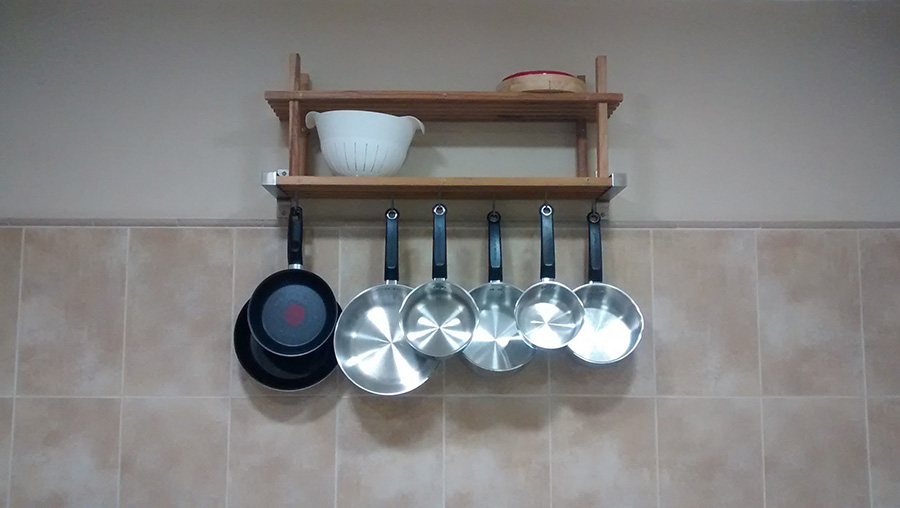
Nest Protectors
Worried about scratching your aluminum or copper pans when stacking them? Don’t worry; you aren’t the first to consider this risk. You can use nest protectors for peace of mind – these are star-shaped pads which you can insert in-between your pans to protect them. As an added bonus, they will absorb any excess moisture, helping to prevent corrosion.
On Display
Let’s not forget one of the most convenient places to store your pots and pans. Keeping your pans on display on your stovetop means they’re always right where you need them. Sometimes it’s best not to overcomplicate things.
Which Pans Can I Use On My Hob?
Many amateur chefs don’t realize that pans can have compatibility issues with their hob until it’s too late. Certain hobs are better suited to certain pan materials, and some won’t even heat your pan at all if it isn’t compatible! Check out our breakdown below to see what pan materials will best match your hob.
Gas
Gas hobs are the most flexible, as they will work with any pan material or shape. Since the heat from gas stoves doesn’t make direct contact with your pans, it can transfer heat even to pans with an uneven base.
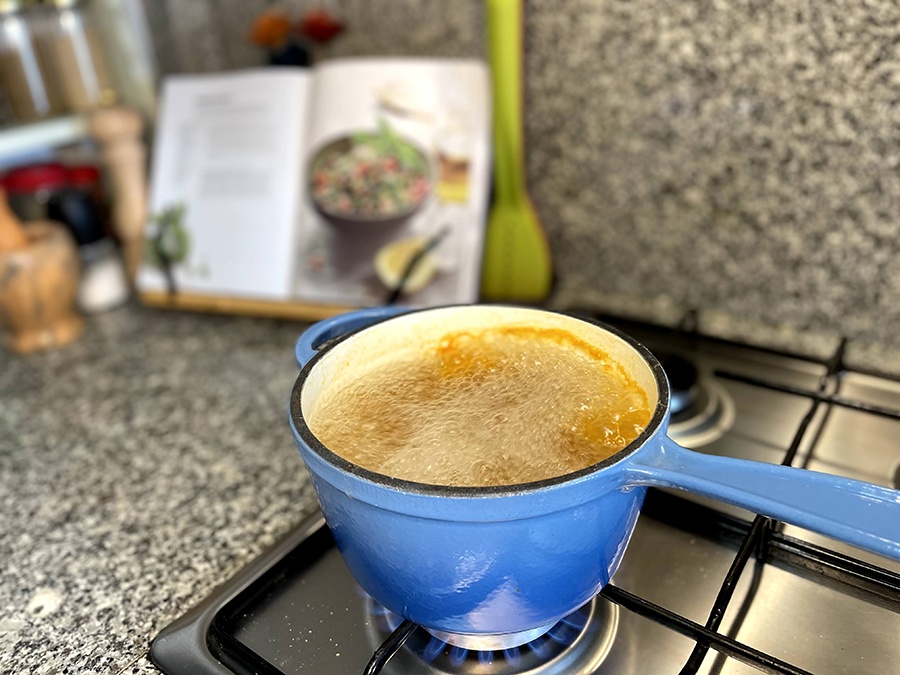
Electric
Electric hobs will work with almost any pan type, but there are some considerations. You will need a pan with a flat base, as electric hobs transfer heat via direct contact with the pan. Electric hobs also take a long time to warm up compared to other hob types, such as gas. Pans that excel at changing temperature quickly, such as copper, may be wasted on a hob that can’t take advantage of these qualities.
Halogen
Halogen hobs provide instant heat, just like gas. While they are electrically powered, they actually produce infrared heat. This means the heat is transferred by radiation (don’t worry; it’s not the type that can harm you, beyond the heat!), as opposed to the conduction used in standard electric hobs.(8) Pans with a shiny base can reflect some of the infrared waves produced by halogen hobs, interfering with their operation – these are to be avoided.
Induction
Induction hobs heat your pan via a magnetic induction coil. This means they don’t actually get hot by themselves, making them significantly safer than other hob types. However, these glass top stoves are also the least flexible hob, as they are only compatible with pots and pans which have a magnetic base, such as stainless steel or cast iron. Aluminum, copper and porcelain pans aren’t compatible with induction hobs, unless they have an iron or steel base, therefore.
Cookware Brands
It’s also helpful to know what some of the best cookware brands in the market are. Below we’ve listed some of the most trusted cookware manufacturers currently that have long established brands. You can be sure that pots and pans sold by the brands below are made to high standards.
All-clad
All-Clad has been making cookware for almost half a century. All-Clad, which was founded by a renowned metallurgy expert, pioneered the use of clad metals in pans. They’re a great brand to check out if you’re interested in this method of construction.
Anolon
Anolon offers stylish cookware sets with a premium feel. They also let you create your own set, by customizing which pots and pans you wish to include.
Calphalon
Calphalon was one of the first cookware companies to make use of anodized aluminum, a process which increases its strength greatly. As such, they have become specialists at pots and pans with this construction, and are a great option for anodized pans.
Circulon
Circulon offers pans at the forefront of technology. Hard-anodized pans with non-stick coatings, dishwasher-safe pans with induction hob capability: they offer pans that can keep up with the modern kitchen’s demands.
Farberware
Farberware’s cookwares, on the other hand, offer convenience. Their pans prioritize style and ease of use, with cool, pastel colors and non-stick coatings.
Le Creuset
Le Creuset’s cookware is iconic. Their colourful enameled cast iron has been owned by figures including Marilyn Monroe: her cookware set sold at auction in 1999 for $25,300.(9)
Swiss Diamond
Swiss Diamond offers their own cutting-edge “XD” non-stick surface, making their cookware great for chefs who value non-stick coatings. Blue Diamond Pans aim to offer something similar at slightly more affordable prices.
T-Fal
The original innovator in non-stick cookware however was T-Fal. T-Fal’s non-stick coatings revolutionized cookware, and they’re still making quality pots and pans to this day.
Tramontina
Tramontina is a cookware brand you can rely on. They have been making cookware for over a century, and have become a favorite of chefs around the globe.
Final Tips and Summary
Pots and pans might seem simple, but as you can see, there’s so much you can talk about. Just as you might put in some extra effort to perfect a recipe, it’s worth considering all of the factors we’ve talked about to let your cookware elevate your cuisine. But most importantly, if you’re stuck with the pots and pans you have for the time being, don’t let that stop you from cooking. Sometimes the best pots and pans are the ones you already have – because they’re the ones that will let you experience the pleasures of cooking right now.
References
(1) Sapra, S. (2018, July 18). Cookware 101: Understanding the anatomy of a pan. Retrieved from https://www.danby.com/blog/cookware-101-understanding-the-anatomy-of-a-pan/
(2) Anatomy of a Pan. (n.d.). Retrieved from https://www.horwood.co.uk/articles/anatomy-of-a-pan.htm
(3) Temperature and pressure calculations – Temperature and gas calculations – GCSE Physics (Single Science) Revision – BBC Bitesize. (n.d.). Retrieved from https://www.bbc.co.uk/bitesize/guides/zc4xsbk/revision/4
(4) Dutch Oven. (n.d.). Retrieved from https://www.merriam-webster.com/dictionary/Dutch oven
(5) Erosion: What You Eat and Drink Can Impact Teeth. (n.d.). Retrieved from https://www.mouthhealthy.org/en/az-topics/e/dietary-acids-and-your-teeth
(6) Leigh, Tishuk, E., & Lorinda. (2020, November 07). Pros and Cons of Porcelain Enamel Cookware. Retrieved from https://www.leafscore.com/eco-friendly-kitchen-products/pros-and-cons-of-porcelain-enamel-cookware/
(7) Cleaning and care instructions of aluminum cookware. (n.d.). Retrieved from http://www.e-magefesa.com/index.php?option=com_content
(8) Oldenburg, B. (n.d.). Conduction, Convection and Radiation. Retrieved from https://www.greenteg.com/heat-flux-sensor/about-heat-flux/3-types-of-heat-transfer/
(9) Our Heritage – Le Creuset. (n.d.). Retrieved from https://www.lecreuset.co.uk/en_GB/our-heritage/cop007.html
